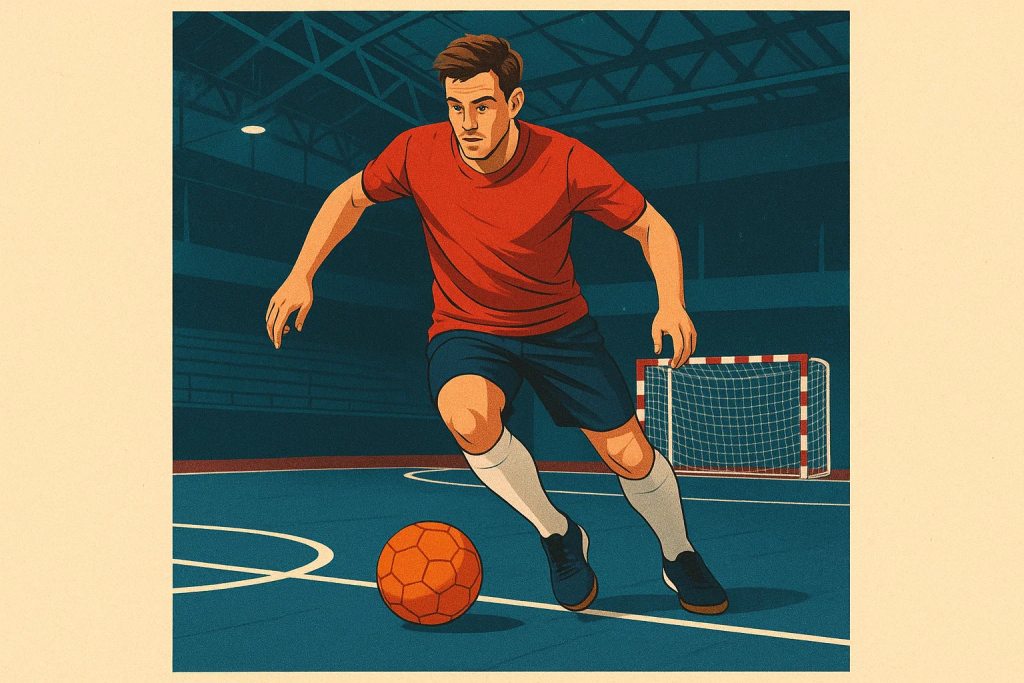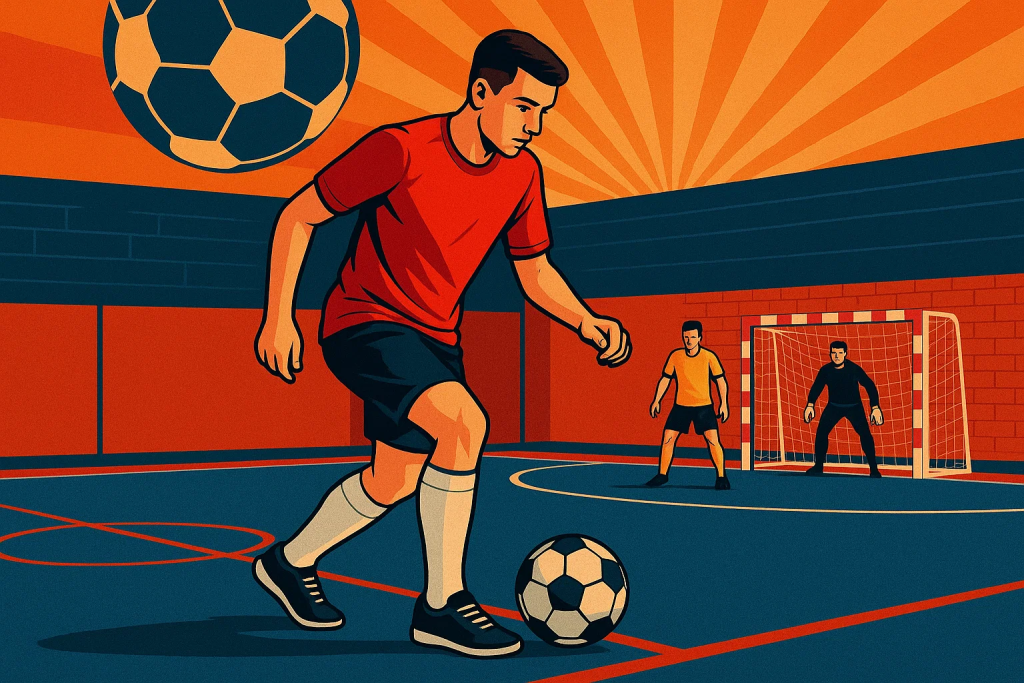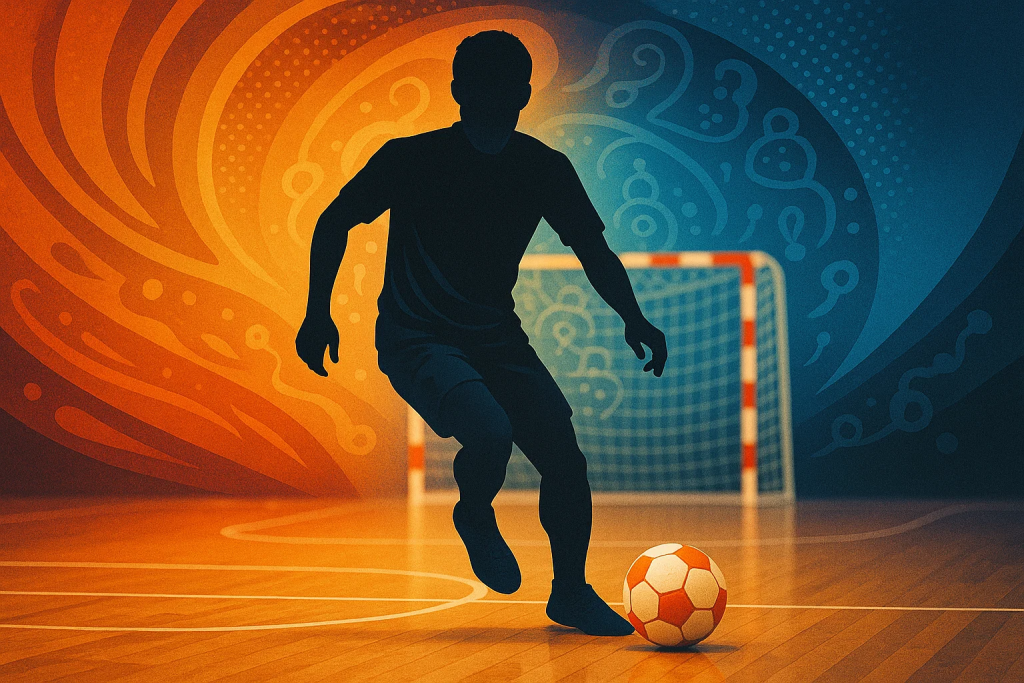Table of Contents
Why non-competitive matches can shape competitive seasons
This long-form guide explains how elite programs extract outsized value from futsal friendlies—from scheduling and session design to analytics, player welfare, and community engagement—so your club can transform “practice games” into competitive leverage. In indoor football, the tiniest angles decide matches—hip orientation on a wall pass, a heel-to-toe acceleration in the lane, a goalkeeper’s micro-shuffle before a 1v1. That’s why futsal friendlies are more than scrimmages; they’re laboratories where habits are forged without the pressure of league points. Plan futsal friendlies well and you compress months of learning into a few high-quality sessions. Mismanage them and you add fatigue without insight.

What success looks like: outcomes to target before you schedule a match
The clearest sign your schedule of futsal friendlies is working is transferability: patterns rehearsed in low-stakes environments show up under pressure on league day. Through futsal friendlies, coaches validate rotations, trigger words, kickoff routines, and late-game pressing chapters. In successful futsal friendlies, you see players reset after errors quickly, lines compress in the right moments, and set-piece deception improve week by week. These are not intangibles; they are observable behaviors you can film, tag, and measure.
Building the calendar: periodization that respects legs, lungs, and learning
Elite staffs anchor futsal friendlies in the macrocycle, not as afterthoughts. For example, you might place two high-intent matches during a four-week build, then shift to lighter loads as cup fixtures loom. International windows for futsal friendlies are excellent for stress-testing depth charts and handing minutes to academy graduates. The rule of thumb: periodize futsal friendlies like you would league fixtures—define objectives, set minutes caps, and plan recovery assets ahead of time instead of chasing ad-hoc invites.
Calendar cues that work
- Place a technical emphasis (e.g., weak-foot build-outs) early in preseason.
- Use opponent styles to create contrast: one high press, one deep block.
- Keep a “red list” of players with cumulative fatigue to avoid overload.
- Pair every match with a next-day recovery standard: nutrition, sleep, and mobility.
Tactical frameworks you can validate without risking points
You don’t need a table to test ideas; you need reps. The smartest staffs use futsal friendlies to stress-test pressing cues (e.g., jump on a negative pass, trap toward the coach’s box) against different exit patterns. In futsal friendlies your rotations can be exaggerated on purpose—over-rotate a pivot to see how the weak-side wing copes, or invert the fixo to start build-outs—then evaluate spacing on film. Set-piece rehearsals in futsal friendlies (corner slips, disguised wall restarts, late-post flash screens) reveal timing issues far faster than drills alone.
Tactical experiments worth running
- Two-phase press: initial trap to the sideline, then an immediate collapse on a back-pass.
- Asymmetric rotation: strong-side overload with a weak-side ISO for your 1v1 star.
- Goalkeeper integration: rehearse quick throws to hit transition windows before the block settles.
- Silent minute: a stretch where only pre-agreed hand signals are allowed to sharpen non-verbal cues.
Microcycles around a match: the week that makes the day
The simplest way to avoid “dead legs” is to script the week. D-2 to futsal friendlies is tactical polish and set-piece timing, not conditioning. D-1 is activation, speed exposure, and a short walkthrough. Post-futsal friendlies recovery is non-negotiable: pooled mobility, protein timing, and a five-question wellness check that flags tight adductors or sore calves before they become absences.
A sample microcycle
- Mon: speed mechanics + constrained games (2v2, 3v2)
- Tue: team tactics, set-pieces, and pattern play
- Wed: off / regen + film
- Thu: match rehearsal, short high-speed exposures
- Fri: captain’s run, special teams, mental prep
- Sat: match
- Sun: recovery and light technical touches
Turning matches into data: the KPI backbone
Subjective “looked OK” notes won’t move your team forward. Tag futsal friendlies with the same KPIs you’ll use when the season kicks: press wins, build-out completions, entries to the red zone, xThreat created, turnovers within three passes, and set-piece efficiency. Comparing league matches and futsal friendlies on these KPIs reveals if improvements are real or just vibes.
Five numbers that predict wins
- Press success % within three passes after the trigger
- Build-out completion across two lines under pressure
- Turnover depth (how close to the opponent’s goal)
- Shot quality (average shot value rather than volume alone)
- Restart conversion (corners, kick-ins, free kicks)
The psychology of rehearsal: training calm in chaos
Confidence is context-specific. That’s why elite coaches use futsal friendlies as pressure labs: simulate a yellow-card deficit, a scoreboard squeeze, or a “need two goals in 90 seconds” drill. Leaders emerge in futsal friendlies when responsibilities are rotated—the shy pivot becomes the huddle voice for a night, or the rookie takes the first touch on a power play. Over time, the huddle language stops sounding like a coach’s echo and becomes the team’s own voice.
Mental routines to install
- 60-second reset: a shared breathing cadence after a conceded goal
- Two-word cueing: “pin early,” “drop five,” “freeze line” to compress instructions
- Error framing: swap “mistake” for “information” during reviews
Scouting and recruitment: film that travels
Your scouting department loves futsal friendlies because opponent game plans are less secretive, making film cleaner for pattern analysis. Film from futsal friendlies also reduces false negatives on prospects who get few league minutes. Invite trialists into futsal friendlies and place them in the exact scenario you care about (e.g., closing a game, breaking a low block) to see decision quality without the noise of a first-team debut.
Scouting checklist
- Record from a high angle to capture spacing
- Clip by theme (press, exit, set piece) not by chronology
- Tag pressing triggers and the first decision after regains
- Log duels in the half-spaces and at the second post
Pathways: graduating talent without breaking rhythm
Academy coaches can set specific carryovers—weak-foot passes, wall balance, timing into the pocket—then report back on how the behaviors held up in the adult environment. The best academies accelerate development by graduating them via futsal friendlies first, then onboarding them to league minutes later. U17 futsal friendlies scheduled beside senior sessions let young players absorb tempo cues, recovery norms, and locker-room standards long before they’re starters.
Pathway rules that work
- Don’t elevate until an academy player dominates their level
- Assign a “big brother/sister” mentor for each call-up
- Review film with both academy and senior coaches present
- Emphasize nutrition and sleep as non-negotiables
Logistics and operations: the “boring” edge
Great planning wins games no one remembers to credit you for. Visa and travel for futsal friendlies should be booked with the same rigor as tournament play: bus windows, snack bags, hydration plans, and kit redundancies. Allocate a quiet room for pre-game focus and a media corner for post-match interviews. When the environment is predictable, the brain saves energy for decisions.
Ops details that matter
- Two camera angles, two match balls per bench
- Laminated set-piece cards by role
- Headset protocol between bench and analyst
- Ref brief that locks restart counts and time-out rules
Player welfare: keeping the roster available
Track adductor squeezes, groin soreness, sleep quality, and ankle stability. Contact load in futsal friendlies should be scaled for players just back from injury; cap minutes, adjust pressing tasks, and assign “no-tackle” roles if needed. After the match, check calf and hip flexor tightness—common red flags in indoor football.
Return-to-play ladder
- Isolated strength → 2. Low-decision ball work → 3. Small-sided constraints → 4. Controlled minutes → 5. Full match readiness
Coaching cues and drills: translating ideas into actions
Pattern play inside futsal friendlies scrimmages is more powerful than isolated drills because it bakes decisions into technique. Use constraints to force the behaviors you want: one-touch in the pocket, two-touch wide, mandatory third-man runs after wall passes. The cue language should be short and repeatable—“show, pin, slice”—so players don’t drown in words.
High-yield constraints
- Three-goal game: only count goals from third-man runs
- Press trap bonus: award points for turnovers won at half
- Switch tax: each unnecessary switch costs a point to promote directness
- Silent press: defenders call only with hand signals to sharpen scanning

Community and brand: making nights that people remember
Clubs that open their doors on match nights multiply the value of rehearsal. Run autograph lines, post-match Q&As, or “kids play the last five” cameo moments. Community nights built around futsal friendlies create lifelong fans, and sponsors prefer predictable, family-safe inventory they can activate with giveaways and sampling.
Fan-first touches
- Free poster for the first 100 arrivals
- Photo booth with instant prints
- QR code to download match clips
- Raffle linked to a community cause
Case studies (hypothetical): models you can borrow tomorrow
Case A: The pressing rebuild
A mid-table club overhauled its press in preseason. Club A used futsal friendlies to layer triggers: first two games focused on the negative-pass jump, the next two added weak-side collapse, and the final rehearsal integrated a goalkeeper “sprint throw” counter. League press-win rates rose 12% in the opening month.
Case B: The set-piece studio
A contender invested ten rehearsals into corners and kick-ins. They tracked screens, runs, and pass speed. By week five, their conversion doubled, and close matches flipped on two choreographed routines that originated in rehearsals.
Case C: The pathway accelerator
Three academy players earned senior debuts after a month of blended sessions. Their first league contributions weren’t dazzling, but they were clean—no costly turnovers, correct rotations, and disciplined pressing. The coaches credited the calm to specific friendly-match scenarios they had already faced.
Templates and checklists for match-day readiness
Pre-match list for futsal friendlies:
- Objective card (one attacking, one defensive)
- Minutes plan by athlete
- Set-piece menu & responsibilities
- Analyst shot list (what to capture from the gantry)
- Recovery menu and post-game wellness check
Post-match review
- 10 clips: three that reinforce behavior, two that ask questions
- KPI sheet filled within 12 hours
- Individual notes delivered before next training
- Medical flags escalated immediately
Common mistakes—and how to avoid them
- Over-scheduling futsal friendlies: the body keeps the score; stack too many and quality drops. Balance high-intent matches with training blocks.
- Undefined goals: “Get a run out” is not a plan. Assign one attacking and one defensive objective per match.
- Ignoring recovery: sleep, protein, and mobility are not optional after high-intent work.
- Film but don’t tag: video without a tagging plan becomes digital clutter.
- Zero community touch: if no one knows or cares you played, you missed a brand opportunity.
Content and SEO: make your work discoverable
Clubs that publish consistent, helpful content build authority—and attract trials, sponsors, and fans. Turn your learnings into short explainers: a 60-second clip on corner deception, a carousel on recovery routines, a blog post summarizing how you trained late-game presses. Maintain a clean content hub with schema markup (FAQ/HowTo) and descriptive alt text. Internal links should guide readers from “what is a pivot?” to “how we trained exit patterns last month,” creating a web of helpful resources that also serves your recruitment.
Budgeting smartly: spend on leverage, not on noise
You don’t need a TV truck to get value from rehearsal nights. Spend on a second camera, comfortable benches, and post-game nutrition before you splurge on pyrotechnics. Seek local sponsors who value family-safe visibility and offer them concrete touches (hydration stations, charging bars, autograph cards). Track ROI with simple dashboards: attendance, email signups, video watch time, and community feedback.
The culture piece: not another drill, a shared ritual
When rehearsal nights feel like a chore, the team’s energy leaks. Treat them as a shared ritual: a quick gratitude circle in the locker room, a clear acknowledgement of who improved a micro-skill, a private motto on the whiteboard. Culture is a hundred tiny reinforcements; the friendliest calendar in the world won’t help if players feel unseen.

Call to action: turn your next friendly into an advantage
Pick one goal—pressing, exits, or restarts—and one behavior to track this week. Script the microcycle, cap minutes, and decide the three clips you’ll show the team 24 hours after the match. Invite a local youth side to watch, open a Q&A corner, and publish a short explainer the next day. Do this for a month and you’ll feel it on league day: decisions arrive faster, spacing tidies itself, and your locker room speaks a common language. The “secret” is no secret—design your rehearsals with intention and respect the details, and your season will thank you.
Futsal friendlies are high-value laboratories, not throwaway scrimmages. When planned inside your macrocycle, they sharpen rotations, pressing cues, set-pieces and late-game behaviors without risking points. Build a calendar with clear objectives, minutes caps and recovery; script microcycles; and tag film with simple KPIs—press wins, build-out completion, turnover depth, shot quality and restart conversion. Use friendlies to stress-test tactics, accelerate pathways for academy players, scout trialists, and rehearse logistics. Protect player welfare with load management and return-to-play ladders. Add community touchpoints to grow the brand. Spend on leverage (video, nutrition) over noise. Define goals, measure, review—then repeat with intention every week.
Frequently Asked Questions
Q1. What’s the single biggest mistake teams make with friendlies?
A1. Playing without a clear objective. Treat every rehearsal like a project: define one attacking and one defensive outcome, assign responsibilities, and review with film and KPIs the next day.
Q2. How many rehearsal matches should we play in preseason?
A2. It depends on fitness levels and calendar congestion, but three to five high-intent matches spaced by full recovery windows is a solid starting point. Quality beats quantity when the goal is transfer to league play.
Q3. How do we keep players fresh when matches pile up?
A3. Cap minutes, rotate responsibilities, and prioritize D-1 sleep and hydration. After the match, enforce a standard recovery protocol—pooled mobility, protein within 30 minutes, and a short wellness check.
Q4. What are the must-track metrics for a small staff?
A4. Keep it simple: press wins within three passes, build-out completion across two lines, turnover depth, restart conversion, and shot quality. Five numbers beat 50 half-measured ones.
Q5. How can we involve our community without distracting the team?
A5. Create predictable, low-friction touchpoints—autograph lines after the final whistle, a photo booth at the entrance, and a two-minute Q&A with staff. Lock timing, keep it brief, and you’ll strengthen bonds without diluting preparation.
